#Galileo spacecraft
Explore tagged Tumblr posts
Text

Blood-red Scars & Veins on Europa ©
#europa#jupiter#planet#astrophotography#nasa#space#solar system#galaxy#astronomy#universe#stars#night sky#cosmos#galilean moons#galileo spacecraft
780 notes
·
View notes
Text

#moon#space#source from nasa#Galileo spacecraft#llorsdood#meme#posting separately for the moon fans out there#can’t decide a caption so setting off into the wild as it is
383 notes
·
View notes
Text
[source]

Galileo Zooms in on Jupiter's Red Spot - August 27th, 1996.
"What does the largest storm system ever recorded look like close-up? This storm system is Jupiter's Great Red Spot and it was captured in detail by the robot spacecraft Galileo. Using real images from three colour filters, the Galileo team were able to compute what a person would see if able to float just above this ancient rotating cloud system. But don't get too close - remember that Jupiter's Great Red Spot is a cold, high pressure area more than twice as wide as planet Earth."
65 notes
·
View notes
Text

"Galileo Inbound" by David Metlesits.
#david metlesits#thefirstfleet#star trek#tos#uss enterprise#galileo#federation starship#spacecraft#shuttlecraft#space shuttle
33 notes
·
View notes
Text

nasa
That’s not a giant bath bomb, it’s our Moon!
We usually see Earth’s Moon in shades of grey, but here in this composite photo made from images captured by our Galileo spacecraft, it’s a riot of reds, oranges, and blues. And sure, it’s pretty, but that’s not the (only) reason we colour images.
The unusual colours in this photograph help scientists study what the Moon’s soil is made of. Areas appearing red generally correspond to the lunar highlands, while blue to orange shades indicate the ancient volcanic lava flow of a mare, or lunar sea. Bluer mare areas contain more titanium than the orange regions do. The deep blue patch on the right is Mare Tranquillitatis, and it’s richer in titanium than Mare Serenitatis, a slightly smaller circular area to the upper left of Mare Tranquillitatis. Finally, the small purple areas found near the centre are deposits formed by explosive volcanic eruptions.
The solid-state imaging system on Galileo captured 15 images of the Moon through three-colour filters while the spacecraft passed through the Earth-Moon system on Dec. 8, 1992. When this view was obtained, the spacecraft was 262,000 miles (425,000 kilometres) from the Moon and 43,000 miles (69,000 kilometres) from Earth. Galileo continued on to its main mission: studying Jupiter. It orbited the planet for almost eight years, made close passes by all the planet's major moons, and ended its mission by intentionally crashing into Jupiter on Sept. 21, 2003.
While this image won’t give you a luxurious bubble bath, meditating on all its colours can be just as relaxing.
Image description: The Moon is awash in shades of red, blue, and orange. The top portion is orange, while the bottom is red, and the middle is blue. The edges of each area are jagged, and some coloured portions surround others. There is a very vibrant blue area right of centre. The very bottom part of the Moon is missing from this composite image.
Credit: NASA/JPL
21 notes
·
View notes
Text

24 notes
·
View notes
Photo
(source)

Galileo’s Europa
Credits: Galileo Project, Univ. Arizona, JPL, NASA
20 notes
·
View notes
Text
NASA’s Juno spacecraft camera images processing
Learn more on the Mission Juno websites: https://www.missionjuno.swri.edu / https://science.nasa.gov/mission/juno
Credit : NASA / JPL-Caltech /SwRI / MSSS / Jackie Branc
#photography#elloon#juno spacecraft#junocam#jupiter#Io#ganymede#astronomy#nasa#nasa photos#missionjuno#nasa jpl#caltech#SwRI#MSSS#astrophotography#planet#space#galileo#galilean moons
15 notes
·
View notes
Text
I collect the final messages of abandoned spacecraft we’ve sent to other celestial bodies, as if they were last words and epitaphs.
I think I’m trying to say, I love you. I will remember you. I will not abandon the memory of you.
I’m trying to say, your existence was necessary, and I am glad for it.
I have days where I think, what will my own last words be?
What will be their legacy? Will somebody care for them? Will somebody tend to them? Shower upon them the kindness of remembrance?
Will I just become a ‘the end’ screen projected onto an unmarked tombstone?
Will I just be a eulogy that ends with good riddance?
#spilled ink#writeblr#writing#spacecraft#InSight#Cassini#Spirit#Messenger#Galileo#Curiosity#Rosetta#last words#(ps. more often than not the last words we receive from spacecraft only reach us after they have died.#what we hear what we read what we study they are all remnants of dead thing. knowledge from a tomb.#we hear the sound of the tree falling in the forest after it has become coal beneath the ground.#to use a different space analogy: we are loving the light that has travelled infinity to reach us. where it comes from no longer exists.#hearing seeing observing studying it is all remembrance.#rememberance first and foremost is kindness)
9 notes
·
View notes
Text


final for my 2D Design class. Very proud of this one🔭🛰️🪐
#astronomy#nasa#space#cassini#galileo#opportunity rover#voyager spacecraft#digital illustration#art student#2d design
12 notes
·
View notes
Text

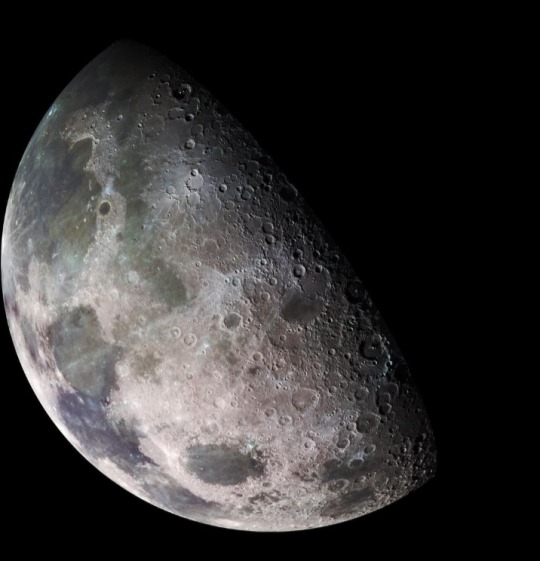
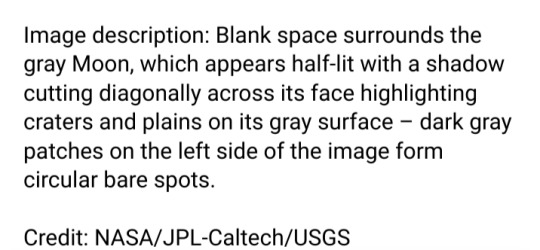
2 notes
·
View notes
Link
Join us for SpaceTime Series 27 Episode 81, where we delve into the latest discoveries and advancements in space exploration.First, new observations from NASA's Juno spacecraft reveal that Jupiter's volcanic moon Io is covered in lakes of molten lava. These findings, published in Communications Earth and Environments, provide a fuller picture of Io's extensive volcanic activity and offer new insights into the volcanic processes at work on this ancient, violent world. Io, slightly larger than Earth's moon, is the most volcanically active world in our solar system due to the gravitational forces from its neighboring Jovian moons and Jupiter itself. Juno's recent flybys have captured high-resolution infrared images showing bright rings surrounding numerous hotspots, indicating that much of Io's surface is covered in lava lakes with caldera-like features.Next, NASA's Mars Perseverance rover has crossed an ancient Martian riverbed in the Jezero Crater, reaching the Bright Angel geological site earlier than expected. This route provided a treasure trove of geological features, including rocks with diverse textures and compositions. Perseverance's exploration of this ancient river channel offers new clues about Mars' geological history and the processes that shaped its surface.Finally, we examine whether space tourism is healthy. New research published in the Journal of the Frontiers of Physiology warns that wealthy, unhealthy individuals venturing into space may face increased health risks, such as pulmonary edema, due to the effects of microgravity on the heart. The study suggests that future space tourists might need to send a digital twin of themselves into virtual space to test their bodies' responses before embarking on the real journey. July Skywatch: What to look for in the night skies throughtout the the month of July with Sky & Telescopes Jonathan Nally. Follow our cosmic conversations on X @stuartgary, Instagram, YouTube, and Facebook. Join us as we unravel the mysteries of the universe, one episode at a time. Sponsor Offer This episode is proudly supported by NordVPN. Secure your digital journey across the cosmos with a VPN service you can trust. Find your stellar security solution at https://www.bitesz.com/nordvpn. Listen to SpaceTime on your favorite podcast app including Apple Podcasts, Spotify, YouTube Music, or wherever you get your podcasts. Support SpaceTime Become a supporter of SpaceTime: https://www.bitesz.com/show/spacetime/support/ www.bitesz.com
#activity#ancient#galilei#galileo#io#juno#jupiter#lakes#lava#mars#martian#nasa#perseverance#river#rover#space#spacecraft#tourism#volcanic#voyager
0 notes
Text
Some facts about my birthday (October 29):
1390: First trials of witchcraft in Paris
1618: Walter Raleigh, colonialist statesman, soldier, and explorer, is tried for treason and executed
1682: The founder of Pennsylvania, William Penn, lands at what is now Chester, PA
1740: James Boswell, diarist and biographer, is born
1863: The International Red Cross is formed in Geneva
1882: Jean Giradoux, playwright and novelist, is born
1888: The Convention of Constantinople allows for free maritime passage through the Suez Canal; Li Dazhao, co-founder of the CCP and mentor of Mao, is born
1889: N.G. Chernyshevksy, author of "What is to be done?", dies
1897: Joseph Goebbels, the nazi, is born
1901: Leon Czogolsz, anarchist, is executed for the assassination of William McKinley
1910: A.J. Ayer, logical positivist, is born
1914: The Ottomans enter WWI
1923: The Ottoman Empire dissolves; Turkey becomes a republic through the efforts of Atatürk
1924: Zbigniew Herbert, poet, is born
1929: Black Tuesday, the crash of the New York Stock Exchange and the beginning of the Great Depression
1938: Ellen Johnson Sirleaf, president of Rhodesia, is born; Ralph Bakshi, animator, is born
1940: The US begins its first peacetime military draft
1948: Franz de Waal, ethologist, is born
1949: George Gurdjieff, philosopher and mystic, dies
1956: The Suez Crisis begins
1962: The Beach Boys release "Surfin' Safari"
1967: Musical "Hair" opens off Broadway
1969: The first computer-computer link established on ARPANET
1971: Ma Huateng, co-founder of Tencent, is born; Winona Ryder, actor, is born
1975: Franco's 36-year long leadership of Spain ends
1985: Evgeny Lifshitz, physicist, dies
1991: The spacecraft Galileo makes the first ever visit to an asteroid
1995: Terry Southern, screenwriter of Dr. Strangelove, dies
2004: Al-Jazeera broadcasts Osama Bin Laden taking responsibility for 9/11; European Union leaders sign the first EU constitution
It is the Christian feast day of:
Abraham of Rostov
Blessed Chiara Badano
Colman mac Duagh
The Duai Martyrs
Gaetano Erico
Michele Rua
Narcissus of Jerusalem
Theuderius
It is a public holiday in:
Cambodia (Coronation Day)
Turkey (Republic Day)
It is a private holiday in:
USA (National Cat Day)
Everywhere (my birthday)
90 notes
·
View notes
Text
[source]

Three Views of Jupiter's Io - October 3rd, 1996.
"The Galileo spacecraft orbiting Jupiter continued to return impressive results. The Galileo team released three more photographs of Jupiter's volcanic moon Io, taken in June, 1996. These three photos are reflected at the bottom of the above picture, digitally enhanced to better show important features. Some areas of Io, it appears, are truly red, not the usual green and yellow hues recorded previously. In fact, the last major mission of the time - Voyager - did not have cameras sensitive to red light. This red material appears to be associated with volcanic eruptions, and the red colour appears to fade with time. Comparisons of these photos with 17-year old Voyager photos showed that about a dozen surface regions - each the size of Connecticut - have been affected by Io's active volcanoes."
38 notes
·
View notes
Text
CAN HUMANS LIVE ON JUPITER'S MOON, EUROPA??
Blog#442
Saturday, October 5th, 2024.
Welcome back,
Life is abundant on Earth, but we haven’t yet found it anywhere else in the universe. How do we search for life beyond our home planet? Scientists say we should look for three key ingredients that make life possible: liquid water, chemistry, and energy. Also, life takes time to develop. We should look for life on worlds where sufficient time has passed for life to get started.
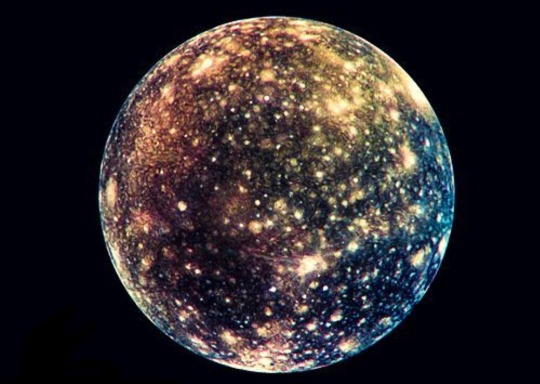
Jupiter’s icy moon Europa may have these essential ingredients and is as old as Earth. NASA is sending the Europa Clipper spacecraft to conduct a detailed exploration of Europa and investigate whether the icy moon, with its subsurface ocean, has the capability to support life. Understanding Europa’s habitability will help scientists better understand the potential for finding life beyond our planet and guide us in our search.
Astrobiology is the study of the origin, evolution, and distribution of life in the universe.
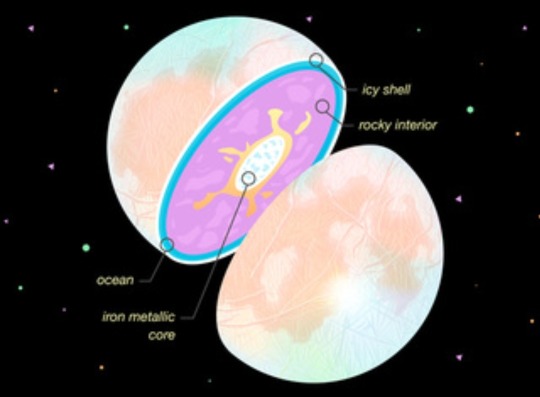
This multidisciplinary field investigates the extremes of life on Earth to inform its search for life in the universe. It encompasses characterizing habitable environments in preparation to search for life.
Liquid water tops the list of ingredients for life, and Europa has lots of it. Scientists think Europa has a salty ocean beneath its icy crust with about twice as much water than all of Earth's oceans combined. Water dissolves nutrients for organisms to eat, transports important chemicals within living cells, supports metabolism, and allows those cells to get rid of waste. Scientists are confident there's a rocky seafloor at the bottom of Europa’s ocean.
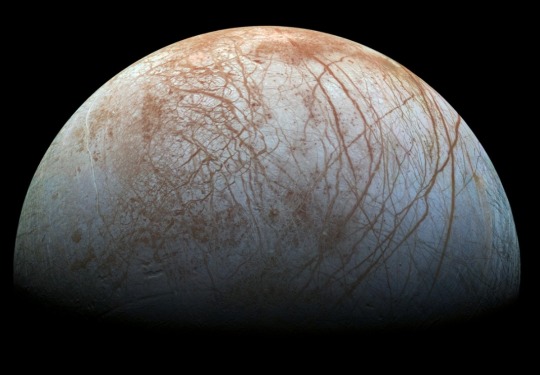
Hydrothermal activity could possibly supply chemical nutrients that could support living organisms.
The best evidence that there's an ocean at Europa was gathered by NASA's Galileo spacecraft, which orbited Jupiter from 1995 to 2003. While Europa has no magnetic field of its own, when the Galileo spacecraft made 12 close flybys of Europa, its magnetometer detected a magnetic field within Europa as Jupiter's powerful magnetic field swept past the moon. Scientists think the most likely cause of this magnetic signature is a global ocean of salty water.
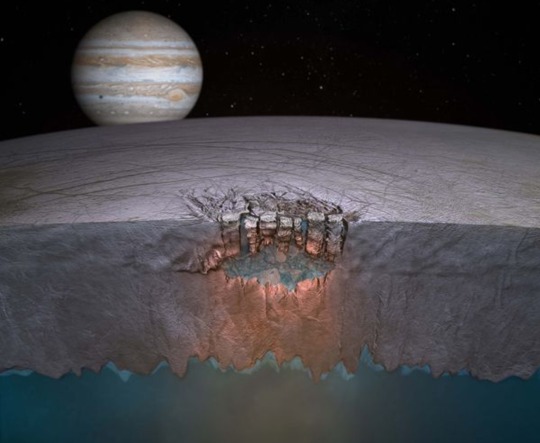
Europa's bright, icy surface is unlike anything seen on Earth. It’s the smoothest body in the solar system, with few towering mountains or deep basins. Ridges and grooves crisscross the surface, breaking up the landscape. Many of these features coincide with long, curving streaks that are dark and reddish in color – some stretching across the surface in great arcs over 600 miles (1,000 kilometers) long. Elsewhere, domes, pits, and jumbles of icy blocks hint that warm ice may be rising from deep below.
Along with water, life as we know it also needs certain chemical elements – the building blocks of life – including carbon, hydrogen, nitrogen, oxygen, phosphorus, and sulfur. These elements are common in the universe and make up 98% of living matter on Earth by combining to form organic molecules essential to life.
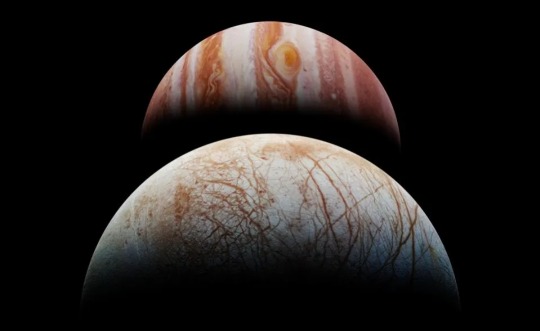
Scientists think these elements were likely incorporated into Europa as the moon formed. Later, asteroids and comets collided with the moon and may have left more organic materials.
The third ingredient for life is energy. All lifeforms need energy to survive. On Earth, most of that energy comes from the Sun. For example, plants grow and thrive through photosynthesis, a process that converts sunlight into energy. The energy is transferred to humans, animals, and other organisms when the plants are eaten.
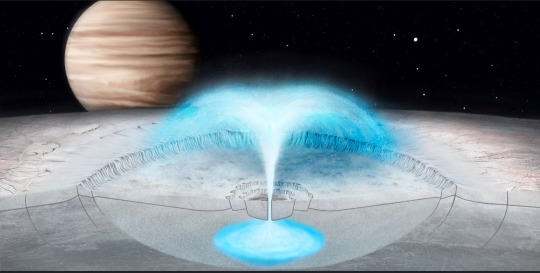
But the type of life that might inhabit Europa likely would be powered purely by chemical reactions instead of by photosynthesis, because any life at Europa would exist beneath the ice, where there is no sunlight.
Europa's surface is blasted by radiation from Jupiter. That's a bad thing for life on the surface – it couldn't survive. But the radiation may create fuel for life in an ocean below the surface.
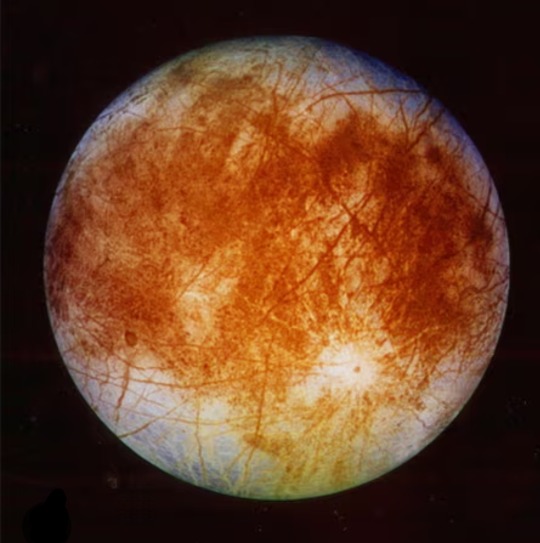
The radiation splits apart water molecules (H2O, made of oxygen and hydrogen) in Europa's extremely tenuous atmosphere. The hydrogen floats away and much of the oxygen stays behind and may bind to other elements. Oxygen is a very reactive element, which means it could potentially be used in chemical reactions that release energy. If the oxygen somehow makes its way to the ocean, it could react with other chemicals to possibly provide chemical energy for microbial life.
Originally published on https://europa.nasa.gov
COMING UP!!
(Wednesday, October 9th, 2024)
"WHAT IS 'NEGATIVE TIME'??"
#astronomy#outer space#alternate universe#astrophysics#universe#spacecraft#white universe#space#parallel universe#astrophotography#jupiter moon#europa
93 notes
·
View notes
Text
Jupiter's moon, Io, is the most volcanic body in the Solar System. NASA's Juno spacecraft has been getting closer and closer to Io in the last couple of years, giving us our first close-up images of the moon in 25 years. Recent JunoCam images show a new volcano that appeared sometime after the Galileo spacecraft visited the region. The new volcano is just south of Io's equator. Since tidal heating from Jupiter causes Io's volcanic activity, most volcanoes are in the moon's equatorial region, within about 30 degrees north and south of the equator.
Continue Reading.
68 notes
·
View notes